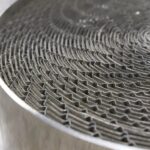The C0110 diagnostic trouble code (DTC) indicates a “Pump Motor Circuit Malfunction.” This error code specifically relates to the Anti-lock Braking System (ABS) and signals a problem within the electrical circuit that controls the ABS pump motor. Understanding this code and its potential causes can help you diagnose and resolve the issue effectively.
The ABS pump motor is a critical component responsible for modulating brake pressure during hard braking or slippery conditions, preventing wheel lockup and maintaining steering control. When the Electronic Brake Control Module (EBCM) detects an open, short, or seized pump motor circuit, it sets the C0110 code, disables the ABS, and illuminates the ABS warning light. This malfunction can compromise vehicle safety, particularly in emergency braking situations.
Common Causes of C0110
Several factors can contribute to a C0110 Pump Motor Circuit Malfunction:
- Faulty ABS Pump Motor: The pump motor itself may be defective due to internal damage, wear, or corrosion. A seized motor due to lack of use or contamination is also a possibility.
- Wiring Issues: Damaged, corroded, or loose wiring within the pump motor circuit can disrupt the electrical signal, leading to the C0110 code. Rodents chewing on wiring harnesses are a common cause of this issue.
- Blown Fuse: The ABS pump motor circuit is protected by a fuse. A blown fuse, often caused by a short circuit, will interrupt power to the pump motor. Always check the designated ABS fuse first (often a 60-amp fuse in the underhood fuse box).
- Ground Problems: A poor ground connection can prevent the pump motor from operating correctly. Corrosion or loose connections at the ground point are frequent culprits. The ground for the ABS system is often located on the frame rail near the driver’s side front tire.
- Faulty EBCM: In some cases, a malfunctioning EBCM can incorrectly detect a problem with the pump motor circuit and trigger the C0110 code. While less common, this possibility should be considered after ruling out other potential causes. An Anti-Lock Brake Traction Control Module malfunction can also trigger this code.
Alt text: A diagram illustrating the location of the ABS fuse in a vehicle’s underhood fuse box.
Diagnosing C0110
Diagnosing the C0110 code requires a systematic approach:
- Visual Inspection: Begin by visually inspecting the wiring harness connected to the ABS pump motor for any signs of damage, corrosion, or loose connections. Check the ground connection for cleanliness and tightness.
- Fuse Check: Using a test light or multimeter, verify that the ABS fuse is not blown. Replace the fuse if necessary.
- Power and Ground Test: With the connector disconnected, use a multimeter to check for power at the ABS pump motor connector. Test the ground connection for continuity.
Alt text: A close-up view of an ABS pump electrical connector with labeled pins.
- Pump Motor Resistance Test: If power and ground are present, disconnect the pump motor and use a multimeter to measure its resistance. Compare the reading to the manufacturer’s specifications to determine if the motor is within the acceptable range.
- EBCM Diagnosis: If all other checks are normal, a more advanced diagnostic tool may be needed to communicate with the EBCM and check for any internal faults.
Alt text: A photo showing the location of ground connections on a vehicle’s frame rail near the front driver’s side tire.
Conclusion
The C0110 Pump Motor Circuit Malfunction can indicate a serious problem with your vehicle’s ABS. Addressing this issue promptly is crucial for ensuring safe braking performance. While simple fixes like replacing a blown fuse or cleaning a ground connection may resolve the problem, more complex issues may require professional assistance. A qualified mechanic can accurately diagnose the root cause and perform the necessary repairs to restore your vehicle’s safety and reliability.

